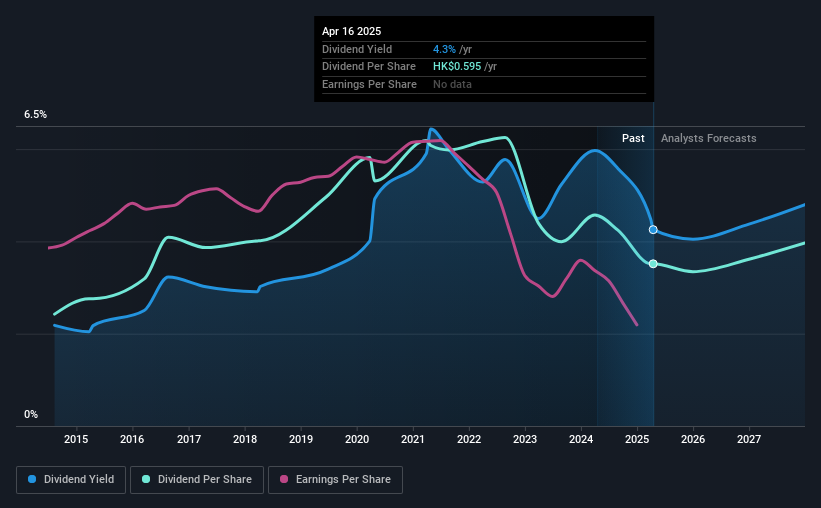
The board of China Overseas Land & Investment Limited (HKG:688) has announced that it will pay a dividend of CN¥0.30 per share on the 17th of July. Based on this payment, the dividend yield will be 4.3%, which is lower than the average for the industry.
We've discovered 2 warning signs about China Overseas Land & Investment. View them for free.China Overseas Land & Investment's Future Dividend Projections Appear Well Covered By Earnings
Even a low dividend yield can be attractive if it is sustained for years on end. However, prior to this announcement, China Overseas Land & Investment's dividend was comfortably covered by both cash flow and earnings. This means that most of its earnings are being retained to grow the business.
Looking forward, earnings per share is forecast to rise by 19.9% over the next year. If the dividend continues on this path, the payout ratio could be 37% by next year, which we think can be pretty sustainable going forward.

Check out our latest analysis for China Overseas Land & Investment
Dividend Volatility
While the company has been paying a dividend for a long time, it has cut the dividend at least once in the last 10 years. Since 2015, the annual payment back then was CN¥0.386, compared to the most recent full-year payment of CN¥0.56. This works out to be a compound annual growth rate (CAGR) of approximately 3.8% a year over that time. The dividend has seen some fluctuations in the past, so even though the dividend was raised this year, we should remember that it has been cut in the past.
Dividend Growth Potential Is Shaky
With a relatively unstable dividend, it's even more important to see if earnings per share is growing. China Overseas Land & Investment's earnings per share has shrunk at 18% a year over the past five years. Such rapid declines definitely have the potential to constrain dividend payments if the trend continues into the future. However, the next year is actually looking up, with earnings set to rise. We would just wait until it becomes a pattern before getting too excited.
In Summary
Overall, the dividend looks like it may have been a bit high, which explains why it has now been cut. In the past, the payments have been unstable, but over the short term the dividend could be reliable, with the company generating enough cash to cover it. We would probably look elsewhere for an income investment.
Companies possessing a stable dividend policy will likely enjoy greater investor interest than those suffering from a more inconsistent approach. Meanwhile, despite the importance of dividend payments, they are not the only factors our readers should know when assessing a company. As an example, we've identified 2 warning signs for China Overseas Land & Investment that you should be aware of before investing. If you are a dividend investor, you might also want to look at our curated list of high yield dividend stocks.
Have feedback on this article? Concerned about the content? Get in touch with us directly. Alternatively, email editorial-team (at) simplywallst.com.
This article by Simply Wall St is general in nature. We provide commentary based on historical data and analyst forecasts only using an unbiased methodology and our articles are not intended to be financial advice. It does not constitute a recommendation to buy or sell any stock, and does not take account of your objectives, or your financial situation. We aim to bring you long-term focused analysis driven by fundamental data. Note that our analysis may not factor in the latest price-sensitive company announcements or qualitative material. Simply Wall St has no position in any stocks mentioned.